Weekly wild news from our reserves - 4 November 2022
Spindle at Bradfield Woods - Alex Lack
The red deer at Dingle Marshes showed a close interest in the trail cam (sound on for full effect). It is currently the deer rutting season when they are much more active and prominent in the landscape.
Autumn at Lound Lakes
Some of our tractors are quite big, so Lound Lakes warden Andy Hickinbotham and his wonderful volunteers have been clearing around gates, cutting back sides and raising the canopy to allow access without damaging the machinery. Their hard work was rewarded with a spot of sunshine and some fabulous fungi.
Winter coppice regime
Winter coppicing has begun at Bradfield Woods. Coppicing is an ancient form of woodland management that involves rotational felling on the same tree stump near to ground level. This allows shoots to regrow from that main stump which is also known as a coppice stool. Coppicing an area (coupe) of woodland allows more light to reach the floor, encouraging regrowth of a wide range of flora including the trees themselves with knock-on associated benefits for other wildlife.
Many woodland plants and insects have evolved to take advantage of this ancient form of management that in part replicates the effects that large herbivores like elephant and rhino (once UK species during interglacial periods) had on woodland ecosystems creating clearings and glades and snapping off stems.
Rotational coppicing across the woodland maximises age structure and allows for successional stages to create all important ‘edge’ habitat. Autumn wildlife abounds at Bradfield with flurries of fungi like this puffball and colourful fruits like this spindle.
Crimson alder
Woodlands Warden Alex Lack was surprised to see this alder stump turn bright red after coppicing. Alder is pale when first cut and usually turns orange, but this one was more crimson – just in time for Halloween!

Alder stump in the coupe turned bright red - Alex Lack
Calm after the storm
The Exmoor ponies at Knettishall Heath don’t take long to dry off after a deluge, this clip shows the rain evaporating from their coats!
A mosaic of habitats
The amazing Knettishall Heath volunteers have been enjoying some beautiful autumn days creating pockets and islands of scrub within the woodland clearings. During work they found this grass snake slough – grass snakes shed their skin once or twice a year to remove parasites and replace old skin and scales.
Pastures new
Our British white cattle have been moved from Hen Reedbeds and brought back to Church Farm for the winter months. The fields have transformed with the recent damp weather and mild days - in the height of summer there was barely a blade of grass at Church Farm. The cows seemed excited to explore the new lush pastures and greet the rest of the herd!
Habitat creation
The gulls at Carlton Marshes certainly approve of warden Gavin Durrant's hard work creating new muddy edges along the old foot drains. We expect many wintering bird visitors and next year's breeding waders will also benefit from this new habitat.

















